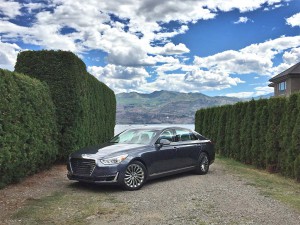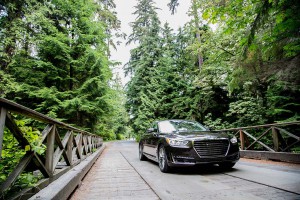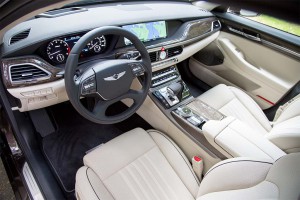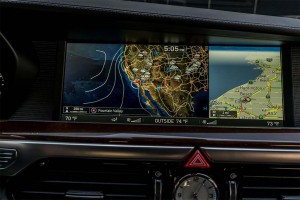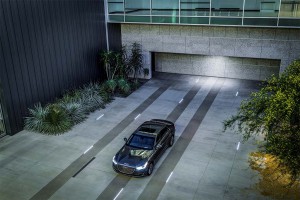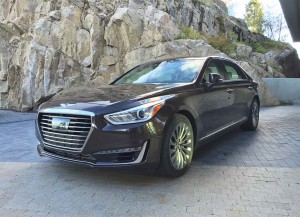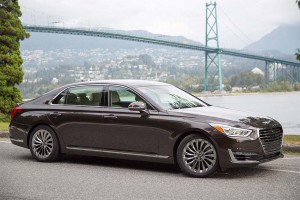Say the name, “Hyundai,” and most folks are likely to think of a small econocar like the original Excel, or perhaps something a little larger and more modern, such as the Sonata. And that’s the problem the Korean carmaker has been struggling with as it has tried pushing into the luxury market with offerings like the Genesis and Equus sedans.
No wonder, then, that Hyundai decided to reverse course last year, announcing plans to launch a separate luxury brand that could more directly be positioned against established high-line competitors like BMW, Lexus and Mercedes-Benz.
The all-new Genesis brand made its debut earlier this year with the launch of the G80, a modestly updated version of the Hyundai Genesis sedan targeted against the likes of the BMW 5-Series and Mercedes E-Class. But now, the Koreans are set to put a halo around the new marque with the roll-out of the big Genesis G90. And we jumped at the chance to take the premium luxury sedan for several hundred miles of driving through the gorgeous mountains outside of Vancouver, British Columbia.
It wouldn’t be wrong to say that the new Genesis G90 replaces the old Hyundai Equus, but that would understate the significant changes made with the new model. The older sedan was an ambitious attempt, but not quite up to the challenge. The Genesis G90 has a few flaws, but it’s a worthy offering that will likely take the competition by surprise. Whether luxury buyers will give it the consideration it deserves is another matter.
(Genesis to add six models by 2021. Click Here for the story.)
The old Equus was comparably sized to its European and Japanese rivals, but the new Genesis G90 finally gets the design right. It is a handsome car with the sort of presence that draws attention wherever we drove it. That should come as no surprise considering former Audi styling chief Peter Schreyer is now one of the vice chairman at Hyundai-Kia Motors. His top lieutenant on the Genesis brand is Luc Donckerwolke, the senior VW designer that followed Schreyer to Korea.
There are the de rigueur luxury cues, of course, the large grille, the extended C-pillar and the long nose that assures you power is primarily coming through the back wheels. There are also the aggressive. 19-inch aluminum wheels which, intriguingly, reveal the focus Genesis has put on subtle details. These alloy wheels contain a special chamber designed to cut road noise by more than half.
The slit headlamps are framed by LEDs, with additional LED marker lamps mounted just above the bumper. The headlamps are bi-xenon on twin-turbo models, LEDs on the V-8 version of the G90.
Inside, the Genesis G90 is swathed in Napa leather, twin-stitched on the instrument panel and gathered elegantly on the seats. We’ll level a minor complaint about cabin’s wood trim, however. It is so heavily lacquered that we found ourselves rapping knuckles on each piece to be sure it wasn’t a well-executed plastic substitute. Something a bit more natural in appearance – perhaps the open-poor veneers the Europeans have adopted – would be appreciated.
On the plus side, there are a number of other well-conceived details. Each row of buttons is contoured slightly differently, to make just-so-perfect contact with one’s fingers, for example. We were particularly pleased with the logic behind the automatic gear shifter.
If you caught recent headlines, you have likely heard about the recall of Fiat Chrysler’s confusing shift lever, which makes it difficult to tell what gear you’re in. That problem has been linked to the runaway Jeep that killed Star Trek actor Anton Yelchin. The shifter in the G90 is another electronic system, but to ensure you don’t leave it in the wrong gear when exiting the vehicle, it automatically shifts to Park if the driver removes their seatbelt and opens the door.
Getting back to buttons, the Genesis product development team resisted the latest fad that calls for virtually everything to be operated by touchscreen. The 12.3-inch display is big enough, but besides the climate and audio buttons, there’s also a rotary knob to handle the numerous functions the infotainment system is capable of managing. On the downside, we found it extraordinarily difficult to locate some controls. Hyundai software programmers need to do a bit more work.
We were also disappointed by the lack of Apple CarPlay and Android Auto and the availability of just one USB port up front.
With those exceptions, a key element of the Genesis strategy is to offer pretty much every possible feature as standard equipment. That includes the 22-way power-adjustable driver’s seat, navigation, power soft-close doors, the 17-speaker Lexicon audio system and the extensive array of safety features.
Though the 2017 Genesis G90 isn’t quite as sophisticated as the latest Mercedes S-Class or BMW 7-Series, there are plenty of safety features, starting with the nine airbags. It offers active cruise control with automatic emergency braking, lanekeeping assist and even a “smart” blind-spot detection system. It will not only warn you if there’s an oncoming car but help keep you from steering into it.
Sound quality has become a big selling point for luxury makers, and here the G90 doesn’t disappoint. Along with those specially designed wheels, the G90 uses acoustic laminated glass all around, and along with other features, it is nearly tomb-quiet inside, even while cruising at 80 mph.
When the original Genesis sedan came out nearly a decade ago, it won generally rave reviews. But it fell short in a few areas, notably ride and handling. That’s been a focus of Hyundai engineers ever since. Significantly, the suspension on the latest version of that sedan, the G80, was tuned by Lotus Engineering. The Korean maker decided to keep things in-house with the G90, and it has done an admirable job.
The big sedan offers four driver-adjustable settings – Smart, Sport, Eco and Individual – to control a variety of vehicle functions, including steering, throttle and dampers. They’re more than just show, ranging from a soft, boulevard-like ride to an almost too-stiff feel in Sport.
Despite its size and mass, the G90 proved surprisingly nimble as we worked up into the mountains, following the shores of 68-mile-long Lake Okanagan.
We had the chance to switch between the two versions of the G90, one featuring an all-new twin-turbo V-6, the other an updated version of the 5.0-liter V-8 found in the old Equus – both paired with an eight-speed automatic with manual shifting mode.
On paper, the 32-valve V-8 might seem the performance driver’s choice. It makes 420 horsepower and 383 pound-feet of torque compared with 365 hp and 376 lb-ft for the 24-valve, 3.3-liter V-6. But, in practice, we found the performance to be virtually identical, delivering estimated 0-to-60 times in the low to mid-5 second range. We found absolutely no turbo-lag on the six, but it managed fuel economy of 23 mpg City, 24 Highway, compared to 15/17 for the V-8., according to the EPA.
One of the few options offered by Hyundai is the choice of rear or all-wheel-drive.
(What’s New for 2017? Click Here to check out the latest models.)
We’d actually like to see one other option. You can only get the LED headlamps and heated/cooled massaging rear seats if you opt for the V-8. Traditionally, the bigger engine was the choice for the most affluent of buyers. But in today’s world, lots of well-heeled customers will likely be torn between going with the cooler, higher-tech engine and the big eight-banger only to get those added features.
Genesis has not yet released pricing. It should follow sometime in September, as dealers start taking deliveries from the factory. The outgoing Hyundai Equus started at $62,450, and the Genesis G90 will be “slightly higher,” hinted Dave Zuchowski, CEO of Hyundai Motor America. But he emphasized that Genesis can’t and won’t try to go head-to-head with BMW or Mercedes. It’s going to have to earn the right, much as Lexus had to when it made its debut in 1989.
That value pricing strategy could work for Hyundai, much as it did for Toyota’s luxury brand – which now frequently outsells its European rivals. But Genesis execs are holding back their ambitions and expect only modest growth over the next five years as they launch an assortment of new passenger car and SUV models.
When launching a new brand, patience is a virtue. All the more so with a luxury marque. It was a challenge getting high-line buyers to seriously consider the old Genesis and Equus models. And, since the new Genesis brand will continue to be sold out of Hyundai showrooms for now, it will likely still be a challenge to draw in loyal BMW and Mercedes buyers, in particular.
That said, the new 2017 Genesis G90 is a full-size luxury car that shouldn’t be ignored. It is solid, well-equipped and fun to drive. And Genesis is adding a suite of new services – including valet pickup and loaners when service or repairs are needed. If the G90 is any indication of what’s to come, Genesis will soon establish itself as a serious luxury player.
(Forget leather and wood. Automakers struggle to redefine luxury. Click Here for more.)

